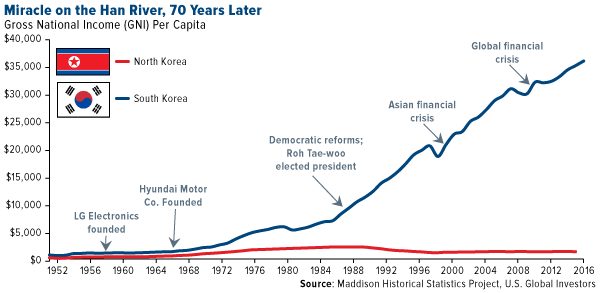Impact on Modern Korea
South Korea’s rapid growth and ascendency has few parallels in the modern world: It is frequently studied and cited as one of the more extreme and successful examples of economic and cultural transformation in the 20th century. Since the end of the Korean War, South Korea has transitioned from one of the world’s poorest countries to the world’s eleventh largest economy — all in the span of three decades. Such a quick turnaround is remarkable for the mere fact that it had taken most industrialized countries nearly a century to achieve similar results, and often at the expense of greater structural or societal stability. For this reason, South Korea’s transformation is frequently refereed to as “The Miracle of the Han River”. But while this title captures the improbable and unprecedented rise of the Korean state and its culture, it does not fully acknowledge the disparate contributions that enabled its success; though aptly symbolic, the Han River localizes the phenomenon to the Korean peninsula and does not address the efforts of its peoples scattered throughout the world. In reality, the miracle was also made possible by the collective efforts of overseas Koreans, who through their devotion to their heritage and homeland ensured that Korea would develop alongside and because of their individual pursuits. The diaspora communities engaged in economic policies and cultural interactions that further propelled their home country to its advanced standing today.
Between 1960 and 1990, the total Korean diaspora had reached over six million, and although it paled in number to the Chinese and Indian diasporic communities, the percentage of the Koreans who had moved abroad and “into the world economy” was considerably greater than that of any other Asian country. It is ever-expanding and dispersed over 151 countries, but as the number of migrants increases, so does the number of potential returnees, thereby creating a process in which the connections between Korea and its overseas peoples become more and more intertwined. As such, the expanding population allowed for a greater burgeoning of Korean culture and opened the possibilities for frequent cross-country interactions, most of which resulted in greater advantages for the South Korean state. Members of the Korean Japanese community, for instance, have invested in the Korean economy since the 1960s and provided the foundations for rapid economic growth; and in the last couple of decades, the South Korean government has encouraged further financial investment from Korean diasporas everywhere. There have frequently been initiatives to develop and strengthen a global network of Korean economic institutions and investors — like the World Federation of Korean Association of Commerce — in the hopes of arousing patriotic sentiment and advancing South Korean concerns. Other times like in the aftermath of the IMF Asian Crisis in 1997, the Korean government has eased policies and called upon the aid of diaspora Koreans to aid the crippling economy. Even recently, when former President Park Geun-hye visited New York City and spoke with leaders and members of the Korean community in the United States, she called upon Korean Americans — and in effect all diasporic Koreans — to “support the globalization of the Korean culture and economy”, by working as “cultural missionaries” and maintain strong connections to the Korean homeland.
Out of all the Korean diaspora communities, the Koreans in Germany are perhaps the greatest proponents of the economic potential of overseas migrants, as they greatly contributed to South Korea’s early development and remain the go-to “success” story. Forming one of the more significant Korean migrations in the 1960s, the miners and nurses moved to West Germany on government contracts and would later settle in Europe or travel onwards to other Western nations. In the hopes of maintaining the German mining industry and hospital system, and in providing the South Korean government with a much-needed source of steady remittances and economic income, the Federal Republic of Germany and South Korea actualized a bilateral labor recruitment agreement in 1963 that was in effect until 1976. In that time period, around 20,000 South Koreans—7,936 miners and 10,723 registered nurses — were sent to West Germany to work as contract migrants. They typically worked for a formal guest work program called Gastarbeiter, where migrants would travel to West Germany and temporarily settle for a few years before ultimately returning to their home country. In theory, there were benefits for both nations: For Germany, the Korean migrants could fulfill a large labor demand in the health and mining industries, while for South Korea, and its president Chung Hee Park, the exported human labor force could form an indispensable part in rebuilding the Korean economy following the Korean War. Echoing this sentiment, it has been considered the Korean government’s “first attempt to relocate Korea’s workforce overseas”, as these immigration agreements pushed Koreans to engage with foreign nations. In this way, the Korean migrants were like their ancestors who traveled abroad at the beginning of the century as a part of labor-incentivized migrations; but unlike those communities, the Koreans here were contributing to domestic financial interests. According to some estimates, about 50 million US dollars were raised and sent by Koreans living in Germany, which comprised anywhere from 1-2% of Korea’s total export value in years like 1965, 1966, and 1967. They were thus encouraged and endorsed by their government to work abroad and contribute to its national cause; the labor agreement was arranged in such a way to suggest that South Koreans could alleviate the turmoil of the Korean War by undertaking these recruitment offers. These sentiments formed the basis for the “p’adok” or “German displacement”: the political term that idealized and defined the labor emigration to West Germany, under President Chung-hee, as a patriotic act. Koreans were made to believe that their efforts were beneficial on both a personal and collective scale.
In the following years, as South Korea’s international standing had grown and greatly improved, the government once again looked towards its diaspora communities to continue economic and cultural growth. Presidents Kim Young-sam and Kim Dae Jung introduced initiatives to better address the needs and status of Korean migrants abroad, like the Overseas Koreans Foundation in 1997. To strengthen the connections between diaspora Koreans and their homeland, the foundation sought to “foster a Korean identity” through educational support, “enhance economic and political cooperation”, and establish widespread “networks among the diaspora Koreans” throughout the world. In December 1999, the Korean government then enacted the Overseas Korean Act, that allowed eligible overseas Korean social benefits and “quasicitizenship rights that ranged from economic to health benefits”, in the hopes of attracting investment and support from diaspora Koreans—especially in the wake of the Asian financial crisis. The OKA was controversial and riddled with inadequacies, as it often excluded Koreans living in China and Central Asia, but it nonetheless was a turning point in the government’s attitude to those living outside its borders. As a result, Koreans abroad could send remittances back to their homeland and exercise their national ties; in doing so, they advanced the notion that the current Korean diaspora was not only valued by its home government, but also necessary. In 2003, the Overseas Koreans Foundation supported this claim by estimating that the economic value of the Korean diaspora was approximately $120 billion, around 25 percent of South Korea’s GDP, and in this way comparable to Chinese and Jewish diasporic communities. The economic incentive was thus prioritized and deeply emphasized. Even though the rate of emigration diminished from 1991 to 2012 the Korean diaspora and its members grew in stature, as their transnational connections were of great value to South Korea’s future development. According to scholar Inbom Choi, South Korea trades more “with a country where more ethnic Koreans reside” than a country with a smaller number, and there is enough data to support the notion that the diaspora engagement policies further increase trade and investment. This can be seen in places like the United States, for instance, where the presence of Korean migrants were responsible for a 15 to 20 percent increase in trade between the US and South Korea. These numbers, beyond demonstrating the economic value of the Korean diaspora, also highlight its maturation, insofar that through these contributions, its overseas migrants have consolidated their place as an indispensable part of Korean society. Their recognition on the part of the South Korean government is noteworthy, for it also opened social discussions on the identity of these Korean migrants and the ways in which they are understood and incorporated into mainstream Korean life. On the other hand, however, as stated by Professor Jo, policies like the Overseas Korean Act “redrew the imaginary ethnic and territorial boundaries of who could constitute the Korean peoplehood and who could not”, without fully acknowledging the complex histories of certain migrant communities. Despite its recognized status, the Korean diaspora was still prioritized for its economic potential, and not completely for the diversity of its growing population.
How much did the Korean Diaspora and Padok Geun Loja (Korean miners and nurses sent to Germany from the 1960s to the 80s) influence and contribute towards the Miracle on the Han River?


Secrets Behind Korea’s Economic Success (sponsored by the Korea Foundation)
For more reading on this topic, please click the link below:
Korean Diaspora in the Making: Its Current Status and Impact on the Korean Economy
